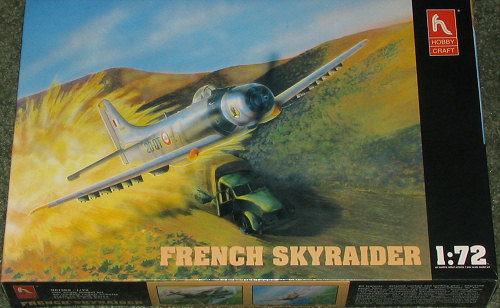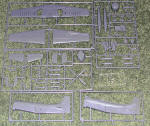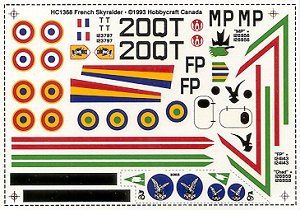
| KIT: | Hobbycraft 1/72 A-1 'French Skyraider' |
| KIT #: | HC 1368 |
| PRICE: | Somewhere around $10-12 when new |
| DECALS: | Four options |
| REVIEWER: | Scott Van Aken |
| NOTES: |

| HISTORY |
The Skyraider was originally designed in the 1940s by Ed Heinemann of the Douglas Aircraft Company, as a simpler alternative to the XBTD-1. At the time of the first prototype's flight on 18 March 1945, it was the largest production single-seater aircraft. The low-wing monoplane design started with a Wright R-3350 radial engine, later upgraded multiple times. Its distinctive feature was the presence of seven hardpoints on each wing, enabling it to carry a tremendous amount of ordnance for its size.
Although the Skyraider entered production too late for active service in World War II, it turned out to be of great value in both the Korean and Vietnam Wars, as its weapon load and 10-hour flying time far surpassed the jets that were available at the time.
One of the Skyraider's most famous roles was as the "Sandy" helicopter escort. In one incident an A-1 pilot landed under fire to rescue another downed A-1 pilot, winning its pilot the Medal of Honor. After November 1972 all A-1s in US service in Southeast Asia were transferred to the South Vietnamese Air Force and their former roles were taken over by the subsonic A-37 Dragonfly and A-7 Corsair II. The Skyraider in Vietnam pioneered the concept of tough, survivable aircraft with long loiter times and large ordnance loads later exemplified by the Fairchild A-10 Thunderbolt II. An A-1 was even credited with downing a MiG-17 that happened to fly across its gunsight.
In addition to serving during Korea and Vietnam as an attack aircraft, it was modified into a carrier-based airborne early warning aircraft (replacing the Grumman TBM-3W Avenger). It served in this function in the USN and Royal Navy, being replaced by the E-1 Tracer and Fairey Gannet respectively in those services.
USAF Major Bernard F. Fisher piloted an A-1E on the March 10, 1966 mission for which he was awarded the Medal of Honor for rescuing Major "Jump" Myers at A Shau Special Forces Camp.
USAF Lieutenant Colonel William A.Jones, III piloted an A-1H on the September 1, 1968 mission for which he was awarded Medal of Honor. In that mission, despite significant damage to his aircraft and suffering serious burns, he returned to his base and reported the position of a downed flight crew member.
| THE KIT |
 I thought this might be a nice comparison with the recently previewed Hasegawa kit. Hobbycraft kits seem to bring out extremes in people. They either like them or hate them. No middle ground seems to be shown. In truth, Hobbycraft kits have been less than consistent in their quality. Some are superb and others are rightfully shunned. These are not Tamiya kits and I doubt if they ever will be. However, they do offer a nice range of subjects. I should mention that most French Skyraiders and the ones on the decal sheet are really AD-4Ns and this kit isn't one.
I thought this might be a nice comparison with the recently previewed Hasegawa kit. Hobbycraft kits seem to bring out extremes in people. They either like them or hate them. No middle ground seems to be shown. In truth, Hobbycraft kits have been less than consistent in their quality. Some are superb and others are rightfully shunned. These are not Tamiya kits and I doubt if they ever will be. However, they do offer a nice range of subjects. I should mention that most French Skyraiders and the ones on the decal sheet are really AD-4Ns and this kit isn't one.
Hobbycraft (and I guess I should say Academy as apparently that is who did all these molds) has often been accused of copying other kits and making enough changes to have it be their own. I'm not sure who would be the father of this one as I don't recall any of the other kits from Tsukuda or Fujimi being molded like this one. The general level of detail is a bit on the soft side, but only a bit. Things are also simplified. For instance, the cockpit is a tub, seat and instrument panel with only circle outlines for instruments. The lower wing has most of the pylons molded in place and the engine is molded in with the cowling.
The kit has no detail behind the cockpit and the there is equal lack of detail in the wheel wells. Wheels are a bit 'off' in that the wheel is sunken in compared to the tire and are the Navy type. you do get a lot of ordnance, including small bombs, rocket launchers and a large centerline tank. Of course, the Skyraider rarely flew with all this stuff, but it is nice to have it. Two other things are separate side speed brakes that can be posed open (though were rarely seen that way o n the ground) and a two piece canopy.
n the ground) and a two piece canopy.
Instructions are typical Hobbycraft in that they are adequate in terms of construction drawings but provide no preliminary painting for interior parts, wheel wells, gear struts and the like. Since this is a 'black box' Hobbycraft kit, the decal sheet is very colorful and quite usable. That is, except for the roundels which all have the center dot off register. Most disappointing as the options are quite nice. You have the box art French aircraft that is destroying a truck somewhere in Algeria or Indo-China, two Gabonese aircraft with different colorful markings and a lone Chadian version, these last three from the mid 1980s. All are in overall aluminum and that is painted aluminum, not unfinished metal.
| CONCLUSIONS |
You've probably realized by now that this one is not going to win any contests without considerable additional pieces. However, it does look like a very nice build as it is. Hobbycraft kits generally fit well and make into very nice shelf models or ones on which to try out a new technique. They can be found for quite reasonable prices at swap meets and other venues so if you want something that isn't going to be a struggle or strain, give one a try.
| REFERENCES |
Wikipedia
November 2006
Thanks to me for picking this up when I thought it was an AD-4N but turned out to be just a standard AD-6.
If you would like your product reviewed fairly and quickly by asite that has over 325,000 visitors a month, please contactme or see other details in the